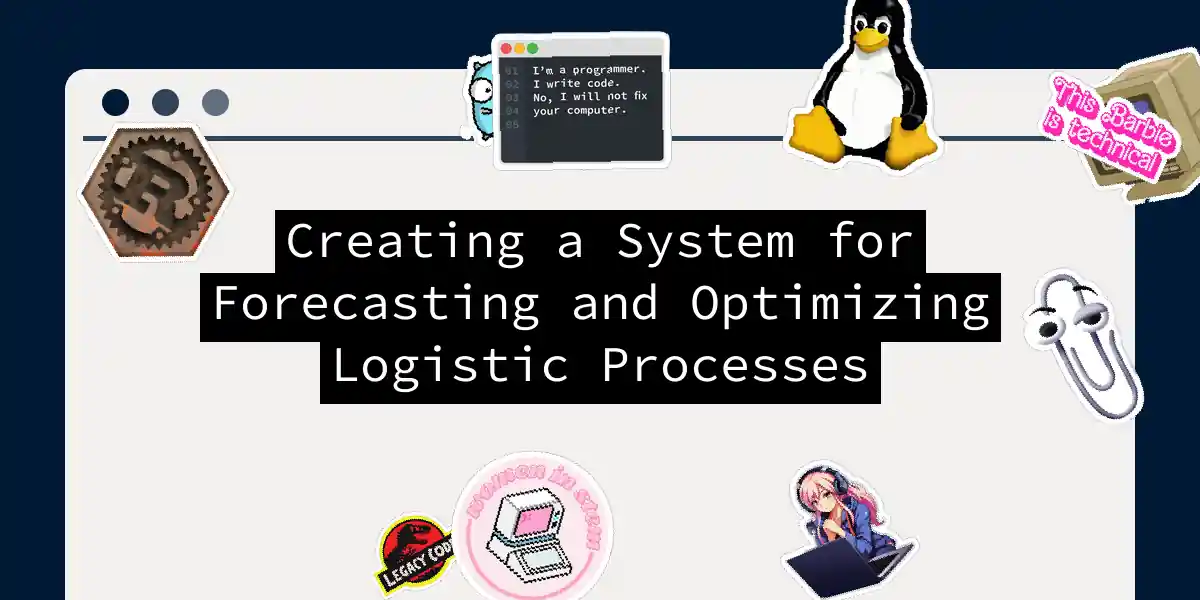The Logistic Puzzle: How to Forecast and Optimize
Logistics, the backbone of any supply chain, is a complex and ever-evolving field. Imagine a giant puzzle where every piece—from warehousing to transportation—needs to fit perfectly to ensure smooth operations. In this article, we’ll delve into the world of creating a system for forecasting and optimizing logistic processes, making your supply chain a well-oiled machine.
Understanding the Challenges
Before we dive into the solutions, let’s understand the challenges. Logistics involves managing a vast amount of data, from inventory levels to transportation routes. Errors in any of these areas can lead to delays, increased costs, and dissatisfied customers. Here are some key issues:
- Data Overload: Managing huge volumes of data related to goods, customers, suppliers, and transportation.
- Inefficient Routes: Poorly planned routes can result in unnecessary fuel costs and delivery delays.
- Inventory Management: Balancing inventory levels to meet demand without overstocking or understocking.
The Role of Technology
Technology is the magic wand that can transform your logistic operations. Here’s how:
Automation
Automation is a game-changer in logistics. Automated warehouse management systems (WMS) and enterprise resource planning (ERP) systems can significantly enhance efficiency.
Automated systems using robotic cranes and conveyor belts can speed up receiving, storing, and shipping goods. Specialized software for route optimization and vehicle management can reduce delivery times and fuel costs.
Data Analytics
Data analytics is another powerful tool. Modern information systems can collect, process, and analyze large volumes of data to identify bottlenecks and propose optimal solutions.
Analytical tools help in optimizing inventory levels, predicting consumer demand, and forecasting changes in supply chains. For instance, analyzing data can help in predicting seasonal fluctuations and adjusting inventory accordingly.
Building the Forecasting System
Forecasting is crucial for any logistic operation. Here’s a step-by-step guide to building a forecasting system:
Step 1: Data Collection
Collect historical data on sales, inventory levels, and other relevant factors. This data will be the foundation of your forecasting model.
Step 2: Choose a Forecasting Model
There are several forecasting models available, including statistical models and machine learning algorithms. For simplicity, let’s consider a basic statistical model.
import pandas as pd
from statsmodels.tsa.arima.model import ARIMA
# Load historical data
data = pd.read_csv('sales_data.csv', index_col='date', parse_dates=['date'])
# Fit ARIMA model
model = ARIMA(data, order=(5,1,0))
model_fit = model.fit()
# Generate forecast
forecast = model_fit.forecast(steps=30)
Step 3: Integrate with Logistic Processes
Integrate the forecasting model with your logistic processes. For example, use the forecasted data to optimize inventory levels and plan shipments.
Optimizing Logistic Processes
Optimization is an ongoing process that involves continuous monitoring and improvement. Here are some practical steps:
Step 1: Analyze Current Operations
Conduct a thorough analysis of your current logistic operations to identify problem areas. This can be done using data analytics tools to evaluate delivery times, transportation costs, and inventory levels.
Step 2: Develop an Optimization Strategy
Based on the analysis, develop a strategy to address the identified issues. This could involve revising delivery routes, optimizing warehouse operations, and improving communication between departments.
Step 3: Automate Processes
Automate as many processes as possible. Use WMS and ERP systems to streamline data processing and reduce errors. Consider implementing electronic document flow systems to speed up communication with suppliers and customers.
Practical Recommendations
Here are some practical recommendations to help you optimize your logistic processes:
Optimize Routes
Use specialized software to optimize delivery routes. This can help reduce fuel costs and delivery times.
Manage Inventory
Implement an integrated inventory management system. Use ABC and XYZ analysis to categorize inventory and optimize stock levels.
Enhance Communication
Improve communication between departments and with suppliers and customers. Use CRM systems to manage client relationships and optimize business processes.
Conclusion
Creating a system for forecasting and optimizing logistic processes is a complex but rewarding task. By leveraging technology, automating processes, and using data analytics, you can significantly enhance the efficiency of your supply chain. Remember, optimization is an ongoing process, so stay vigilant and keep improving.
As you embark on this journey, keep in mind that every small improvement can add up to make a big difference. So, go ahead, roll up your sleeves, and start optimizing those logistic processes. Your supply chain (and your customers) will thank you.
